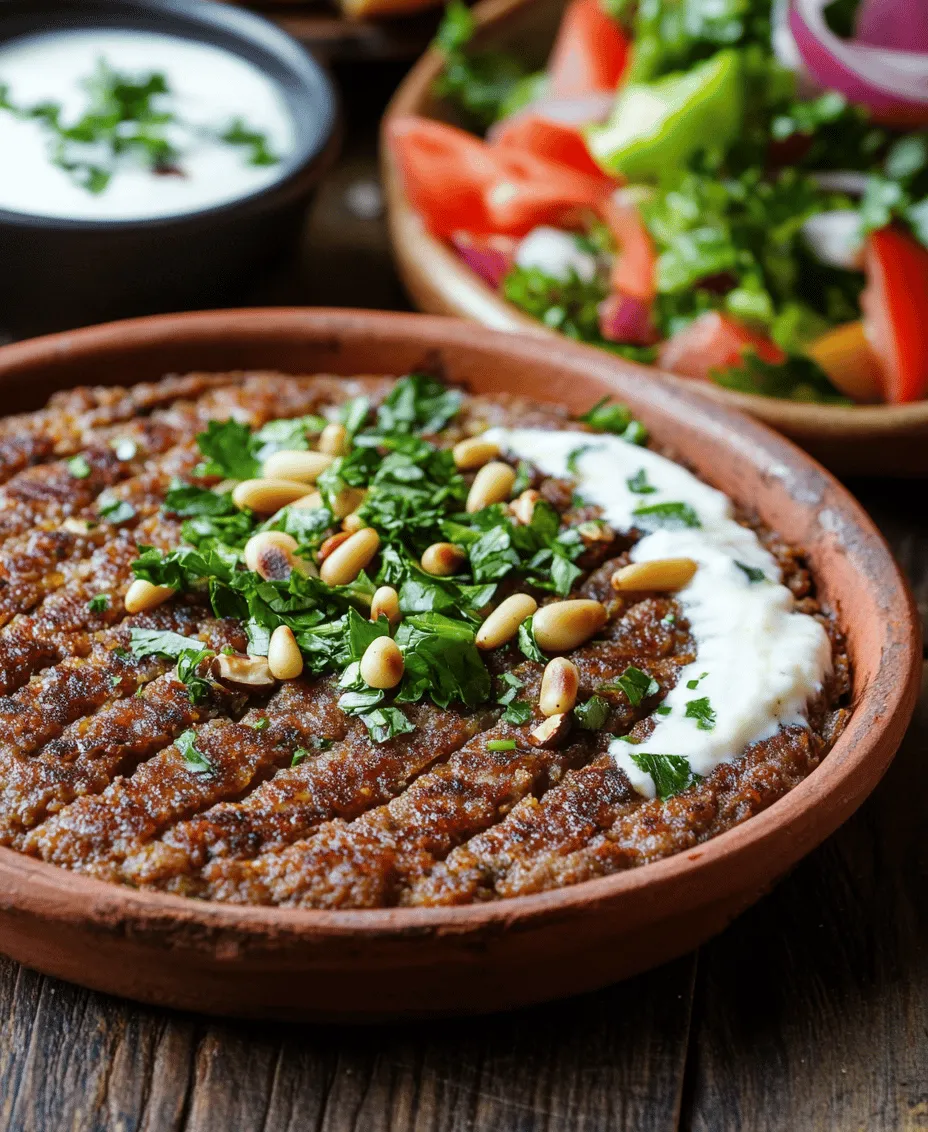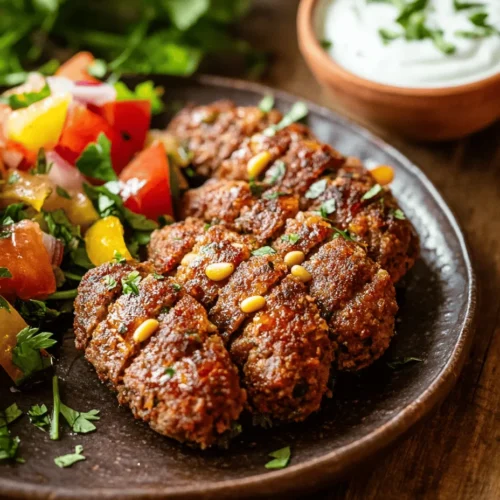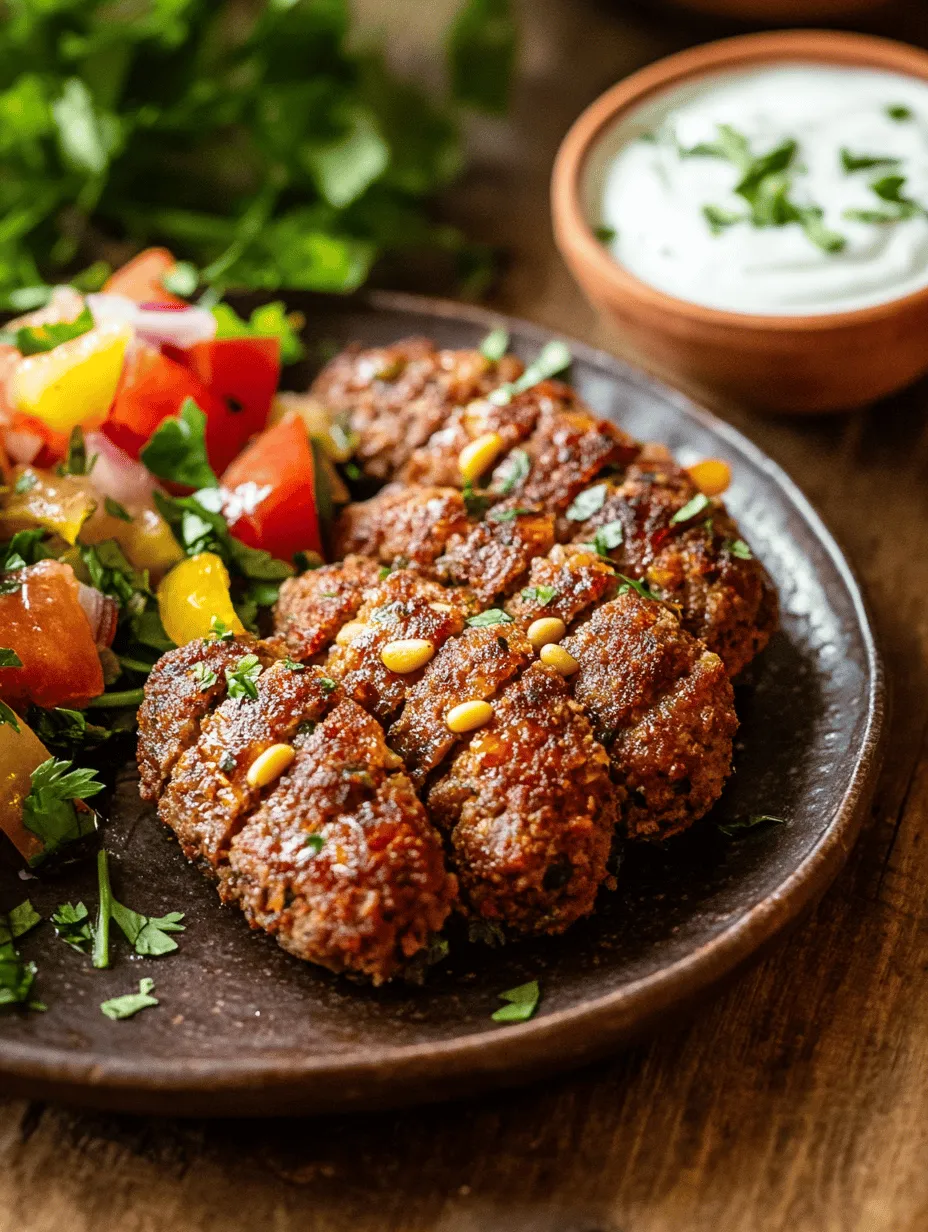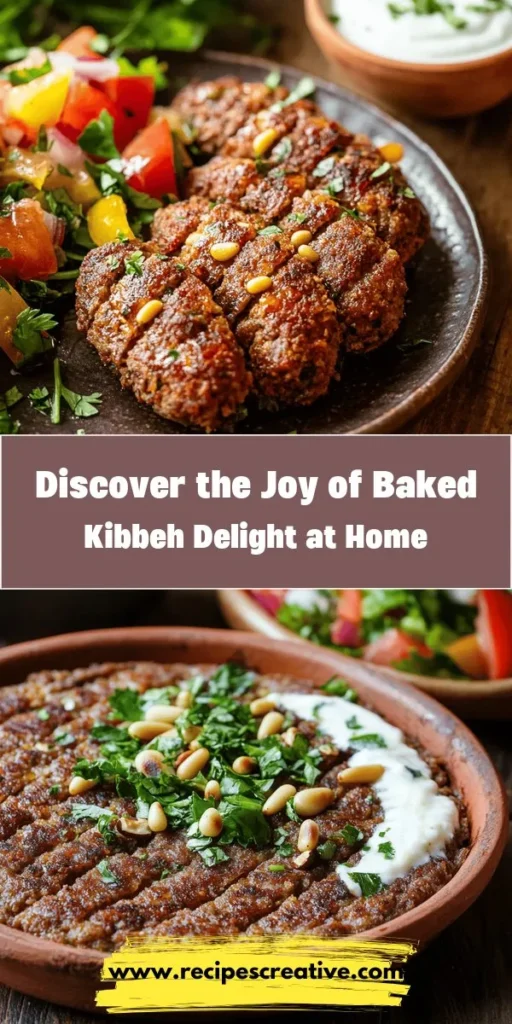Introduction
Baked Kibbeh Delight is a traditional Middle Eastern dish that brings together the rich flavors and textures of bulgur wheat, ground meat, and aromatic spices. This hearty dish is not only satisfying but also showcases the culinary heritage of the region. Originating from Lebanon and spreading across various Middle Eastern countries, Kibbeh has become a beloved symbol of communal dining and festivity. The dish is often associated with family gatherings, special occasions, and holidays, making it a staple in many households. In this article, we will delve into the history and cultural significance of Kibbeh, provide a detailed recipe, and guide you through the preparation process, ensuring that you can create this delightful dish at home.
Understanding Kibbeh: A Culinary Tradition
Exploring the Origins of Kibbeh
Kibbeh’s roots can be traced back to ancient civilizations in the Middle East, where it was crafted as a way to preserve and elevate the flavors of available meats and grains. The word “Kibbeh” itself is derived from the Arabic term “kubbah,” which means “ball” or “shape,” referring to the dish’s characteristic form. With its combination of ground meat, bulgur wheat, and spices, Kibbeh has evolved into numerous regional variations, representing the diverse cultures and traditions of the Middle East.
In Lebanon, the dish is typically made with finely ground meat and a well-seasoned bulgur shell. In contrast, Syrian Kibbeh may incorporate a wider array of spices, while Iraqi versions often feature unique fillings and preparation methods. Each culture adds its distinct touch, reflecting local ingredients and culinary practices, yet all share a common love for this delicious dish.
Kibbeh also holds a special place in communal dining. It is often served at large gatherings, where families and friends come together to enjoy a meal. In many Middle Eastern cultures, sharing food is a way to foster connections and strengthen bonds, making Kibbeh a dish that is not only nourishing but also significant in promoting community and tradition.
The Nutritional Benefits of Kibbeh
Baked Kibbeh Delight is not only a treat for the palate but also a nutritious option on your dining table. The main ingredients—bulgur wheat, ground meat, and a variety of spices—contribute to a well-rounded meal that provides essential nutrients.
Bulgur Wheat: This whole grain is a primary ingredient in Kibbeh and is packed with dietary fiber, which aids in digestion and promotes a feeling of fullness. It is also a good source of vitamins and minerals, including magnesium, iron, and B vitamins, making it a healthier alternative to refined grains.
Ground Meat: Whether you choose lamb, beef, or a combination, the meat in Kibbeh serves as a rich source of protein, essential for muscle repair and growth. Moreover, it provides vital nutrients like zinc and vitamin B12, which are important for overall health.
Aromatic Spices: Kibbeh is known for its bold flavors, thanks in part to the spices used in the recipe. Spices like cinnamon, allspice, and cumin not only enhance the dish’s taste but also carry health benefits. For instance, cinnamon is known for its anti-inflammatory properties, while cumin aids digestion and boosts immunity.
For those looking to adapt the recipe to different dietary preferences, vegetarian alternatives to Kibbeh are also available. By substituting the meat with lentils or chickpeas, and using vegetable broth, you can create a delicious and wholesome vegetarian version without sacrificing flavor.
Ingredients Breakdown
Before we dive into the step-by-step preparation of Baked Kibbeh Delight, let’s take a closer look at the essential ingredients that make this dish truly special.
The Kibbeh Shell: Essential Components
Bulgur Wheat:
The cornerstone of Kibbeh, bulgur wheat, is a cracked whole grain made from durum wheat. It is precooked, making it quick to prepare and an excellent source of fiber. The bulgur gives the dish its signature texture, binding the filling while providing a nutty flavor that complements the seasoned meat.
To prepare the bulgur for Kibbeh, it is essential to soak it in water until it softens, allowing it to absorb the moisture and swell. This process ensures that the bulgur has the right consistency to form the outer shell of the Kibbeh.
Spices:
The spices used in Kibbeh are what elevate the dish from simple to extraordinary. Commonly used spices include:
– Cinnamon: Adds warmth and sweetness.
– Allspice: Imparts a unique and aromatic flavor.
– Cumin: Contributes earthiness and depth.
These spices should be used in moderation, as they can easily overpower the dish. A careful balance will allow the flavors to meld beautifully, creating a harmonious taste experience.
Ground Meat:
Traditionally, Kibbeh is made with lamb or beef, but you can also experiment with other meats, depending on your preference. When selecting ground meat, look for cuts that are not too lean, as a bit of fat helps keep the Kibbeh moist and flavorful. If you prefer a lighter version, lean ground turkey can also work well.
The Filling: Creating Layers of Flavor
The filling of Baked Kibbeh Delight is where the dish truly shines, providing an explosion of flavors and textures.
Key Ingredients for the Filling:
– Onions: Sautéed onions form the base of the filling, adding sweetness and depth.
– Pine Nuts: These little gems add a delightful crunch and a rich, buttery flavor that complements the meat.
– Parsley: Fresh parsley adds brightness and freshness to the filling, balancing the richness of the meat.
In addition to these core ingredients, you may also want to include spices and herbs that enhance the overall flavor profile. A sprinkle of black pepper or a touch of nutmeg can add an extra layer of complexity to the filling.
Olive Oil’s Role:
Olive oil plays a critical role in both the filling and the cooking process. It not only helps to sauté the onions and nuts, but it also contributes healthy fats to the dish. Using high-quality extra virgin olive oil will enhance the flavor and richness of the Kibbeh, ensuring that every bite is a delicious experience.
With all these ingredients in mind, we are now ready to embark on the journey of creating Baked Kibbeh Delight. The next section will provide a clear and detailed step-by-step guide to help you prepare this aromatic and flavorful dish from scratch. Get ready to bring the essence of Middle Eastern cuisine to your kitchen!

Preparing the Bulgur Dough: A Crucial First Step
Creating the perfect bulgur dough is essential for a successful Baked Kibbeh Delight. The texture and flavor of the dough play a significant role in the overall experience of this dish.
The Soaking Process: Why Boiling Water is Essential
Start with fine bulgur wheat, typically available at Middle Eastern markets or health food stores. Measure out the amount you need for the recipe—usually about two cups. The soaking process is crucial as it leads to the ideal texture of the dough.
Boil water in a kettle or a pot. Once boiling, pour the hot water over the bulgur in a large bowl. The ratio is generally one part bulgur to one part water, so adjust accordingly. Cover the bowl with a lid or a clean kitchen towel and let it sit for 30 minutes. This allows the bulgur to absorb the water fully and soften, making it easier to knead into a smooth dough.
Kneading Techniques for Achieving the Perfect Dough Consistency
After the bulgur has soaked, it’s time to knead it. Drain any excess water, if necessary, and place the bulgur in a large mixing bowl. Here’s where your hands come into play. The goal is to achieve a smooth, pliable dough.
Add a pinch of salt and a drizzle of olive oil to enhance the flavor. Begin kneading the bulgur with your hands, pressing and folding the mixture until it becomes slightly sticky but maintains its shape. This process can take about 5-10 minutes. You should achieve a dough that is smooth and elastic, which will hold together well when assembled into Kibbeh.
Crafting the Filling: Building Flavor
The filling is the heart of your Kibbeh. A well-prepared filling not only adds flavor but also brings texture and richness to the dish.
Sautéing Onions: Tips for Achieving the Right Texture
Start with two medium-sized onions. Finely chop the onions and heat a couple of tablespoons of olive oil in a skillet over medium heat. Once the oil is shimmering, add the onions and sauté until they become translucent and golden, which should take about 7-10 minutes.
Avoid rushing this step; allowing the onions to caramelize adds a sweet, rich flavor to the filling. Stir occasionally to ensure even cooking and prevent burning. If desired, you can add a pinch of salt to help draw out moisture from the onions.
Cooking Ground Meat: Techniques for Even Browning and Flavor Development
For the filling, use about one pound of ground lamb or beef, depending on your preference. Once the onions are perfectly sautéed, add the ground meat to the skillet. Increase the heat slightly to medium-high and break the meat apart with a wooden spoon.
Cook until the meat is browned and cooked through, typically around 8-10 minutes. Make sure to stir frequently to ensure even cooking and to break up any clumps. Season the meat mixture with salt, pepper, and spices such as allspice, cinnamon, or cumin for added depth of flavor. After cooking, remove the skillet from heat and allow the filling to cool slightly before proceeding to the next step.
Assembling the Kibbeh: Layering for Success
Assembling your Kibbeh can seem daunting, but with the right techniques, it becomes an enjoyable part of the cooking process.
Tips for Greasing the Baking Dish Effectively
Select a baking dish that suits your needs, typically a 9×13-inch dish works well for this recipe. Generously grease the bottom and sides of the dish with olive oil or cooking spray. This will prevent sticking and ensure easy removal once the Kibbeh is baked.
Techniques for Flattening and Layering the Bulgur Mixture
Divide the bulgur dough into two equal portions. Take one half and press it into the bottom of the greased baking dish, spreading it evenly across the surface. Use your hands or a spatula to flatten the dough to about half an inch thick. Ensure there are no holes or cracks in the dough, as this will hold the filling in place.
Once the bottom layer is ready, spread the cooled meat and onion filling evenly over it. Make sure to cover the entire surface without any gaps.
Take the second half of the bulgur dough and flatten it out in the same manner as the first portion. Carefully place it over the filling, making sure to seal the edges by pinching the dough together. This will create a beautiful layered appearance and help keep the filling secure during baking.
Sealing Edges: Ensuring a Perfect Bake and Presentation
To achieve a polished look, use a sharp knife to trim any excess dough hanging over the edges of the baking dish. After sealing the edges, score the top layer of dough with a knife in a diamond or square pattern, being careful not to cut all the way through to the filling. Scoring helps the Kibbeh cook evenly and allows for easy serving once baked.
The Baking Process
Now that your Kibbeh is assembled, it’s time for the baking process to bring all those beautiful flavors together.
Achieving the Perfect Bake
Before placing the dish in the oven, preheat it to 375°F (190°C). The importance of temperature control cannot be overstated. A properly preheated oven ensures that the Kibbeh cooks evenly and develops a golden, crispy top.
Scoring Techniques for Even Cooking and Presentation
As mentioned earlier, scoring the top layer of dough is essential. This technique not only aids in even cooking but also creates an attractive presentation once baked. The scored lines allow steam to escape, preventing the top from becoming soggy.
The Visual Cues for Doneness: What to Look for in Color and Texture
Bake the Kibbeh for about 30-40 minutes or until the top is a rich golden brown. The edges should pull away slightly from the sides of the dish, and the scored lines will become more pronounced. Use a toothpick or knife to check for doneness—insert it into the center; if it comes out clean, your Kibbeh is ready.
Serving Suggestions
Baked Kibbeh Delight is delicious on its own, but pairing it with the right accompaniments can elevate your culinary experience.
Traditional Accompaniments: Yogurt Sauce and Fresh Salad
Serve your Kibbeh with a side of tangy yogurt sauce. To make a simple yogurt sauce, combine plain yogurt with minced garlic, a squeeze of lemon juice, and a sprinkle of salt. This creamy sauce perfectly complements the savory flavors of the Kibbeh and adds a refreshing element to each bite.
Additionally, a fresh salad made with chopped cucumbers, tomatoes, and parsley dressed in olive oil and lemon juice makes for a vibrant side dish. This balance of flavors and textures enhances the overall meal.
Creative Serving Ideas: Side Dishes That Complement Kibbeh
For a more substantial meal, consider serving Kibbeh with a side of roasted vegetables or a warm grain salad with quinoa or couscous. The nutty flavors and textures of these sides pair well with the savory Kibbeh, providing a complete dining experience.
If you’re feeling adventurous, try adding a spicy harissa sauce or a dollop of tahini to your plate for an added kick. These elements introduce new flavors that can transform your meal into a culinary exploration.
Conclusion
Baked Kibbeh Delight is more than just a meal; it is a celebration of flavors, history, and community. By following this detailed guide, you can recreate this traditional dish in your kitchen, bringing a taste of the Middle East to your table. Whether you are serving it at a family gathering or enjoying it as a comforting weeknight dinner, Kibbeh is sure to impress and satisfy.
Embrace the experience of cooking and savor the delightful results of your efforts. The warmth of the spices, the richness of the meat, and the satisfying crunch of the baked dough come together to create a dish that not only nourishes the body but also feeds the soul. Enjoy the journey of making Baked Kibbeh Delight, and share this treasured recipe with family and friends, inviting them to partake in the flavors of tradition.



